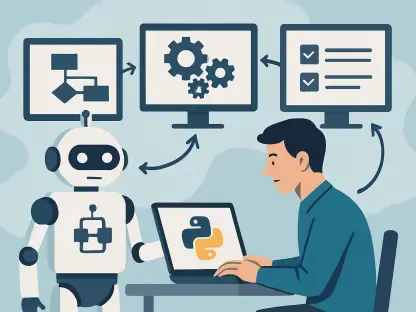In the vibrant world of software development, the infusion of artificial intelligence over recent years has precipitated a remarkable transformation. In 2025, AI coding tools have become indispensable allies for developers, deeply woven into the tapestry of the modern software engineering landscape. Over 90% of development teams now leverage these AI-powered assistants in various stages of their workflows, underscoring an irrevocable shift in how software is crafted. This widespread adoption is not just a mere trend; it reflects a fundamental change in the development ethos, driven by the promise of enhanced efficiency and reduced cycle times. Surveys of industry professionals reveal that developers, relying on these AI tools, often cut their project timelines significantly, enabling teams to deliver value at an accelerated pace. The need to stay competitive in such a dynamic industry propels vendors into a fierce race, continually unveiling innovative features that further enrich the capabilities of these AI assistants.
The Impact of AI on Software Development Workflows
AI coding assistants stand at the forefront of a pivotal change in software development, revolutionizing traditional norms and introducing efficiencies previously beyond reach. These AI tools streamline coding tasks, allowing developers to prioritize strategic design and inventive processes over repetitive duties. With the power to autonomously complete code snippets, identify bugs, and suggest enhancements, AI empowers coding teams to focus on more substantive challenges. The breadth of AI’s capabilities now extends through most phases of software development, from initial design to production deployment. These assistants are not limited by language barriers or framework constraints, exhibiting a versatile grasp of complex contexts across various platforms. This adaptability is crucial in a field where understanding the nuanced interplay of diverse coding environments can make the difference between success and oversight.
The financial accessibility of AI tools plays a crucial role in their expansive reach. Multiple pricing models, from free tiers to flexible subscription plans, make these tools accessible to developers with varying budgetary considerations. The competition among vendors to cater to a diverse array of clientele, from nascent startups to established enterprises, has democratized access to cutting-edge technology. Crucially, seamless integration into popular development environments, such as IDEs and cloud-based platforms, ensures that AI tools augment rather than disrupt established workflows, allowing teams to derive maximum benefit without significant adjustments to their current practices.
Key Innovations in AI Coding Tools
Significant technological advancements characterize the AI coding tools of 2025, which have evolved to offer sophisticated automation and context-awareness capabilities. A salient feature is the emphasis on accelerating automation of routine coding tasks, liberating developers to concentrate on problem-solving and creative innovations. These tools utilize machine learning algorithms trained extensively on public code repositories, sharpening their ability to produce code that is both efficient and contextually appropriate. Such advancements have given rise to efficient software development operations, ultimately benefiting businesses by enhancing adaptability and response time to market demands.
In tandem with advanced automation, these AI systems exhibit a profound understanding of context across varying programming languages and frameworks. Employing deep analysis of code patterns, they maintain a keen awareness of project-specific dynamics and provide tailored suggestions that align precisely with the developer’s immediate needs. This level of sophistication enhances not only the speed of code generation but also its accuracy and suitability for the intended application, thus fostering a more innovative and effective software development environment. Satisfaction with these advanced features is evident in the increasing reliance on AI-driven technology to meet contemporary coding challenges.
Balancing Cost, Integration, and Privacy
While the merits of these AI tools are substantial, their successful adoption often depends on several crucial considerations, including cost, integration with existing systems, and data privacy. The fiscal aspect cannot be overlooked, especially in an era where budget constraints are a prevalent concern across industries. As vendors offer a range of pricing strategies, thoughtful evaluation of an assistant’s cost-effectiveness relative to its features and enhancements remains paramount for developers and stakeholders.
Integration plays an equally pivotal role in the effectiveness of AI assistants. Smooth compatibility with popular code editors and integrated development environments is essential, as disruptions or cumbersome adaptations can offset the productivity gains these tools promise. Whether catering to cloud-based systems, terminal-first workflows, or robust IDE environments, the choice hinges on the unique demands of a project’s infrastructure and logistical parameters.
Data privacy, a complex and sometimes contentious issue, deserves thorough assessment, particularly for organizations operating within stringent regulatory frameworks. Understanding how AI tools handle data—pertaining to storage, logging, and external service integrations—not only bolsters security but also aligns development practices with organizational and legal standards. Effective management of data privacy is crucial, fostering confidence and compliance while minimizing exposure to potential risks.
Looking Forward: The Future of AI in Development
AI coding assistants are at the cutting edge of a transformative era in software development, altering traditional practices and bringing previously unattainable efficiencies within reach. These AI-driven tools optimize coding tasks, enabling developers to focus on strategic design and innovation instead of repetitive chores. With capabilities like autonomously completing code snippets, identifying bugs, and suggesting improvements, AI allows teams to tackle more substantial challenges. The scope of AI’s functionality now spans nearly all phases of software development, from initial design to final deployment.
Crucially, these assistants transcend language barriers and framework limitations, demonstrating a broad understanding of complex contexts across multiple platforms. This adaptability is key in a field where grasping the subtle interactions of diverse coding environments can differentiate between success and failure.
AI tools are financially accessible, with various pricing models, from free options to flexible subscriptions, accommodating developers of all budget levels. The competition among vendors to attract a wide range of customers—from startups to large enterprises—has made cutting-edge technology more accessible. Additionally, the seamless integration of these tools into popular development environments, like IDEs and cloud-based platforms, ensures they enhance rather than disrupt workflows, allowing teams to reap maximum benefits without major changes to their established practices.









